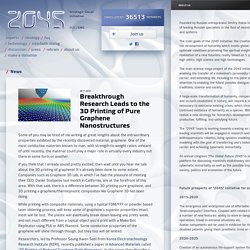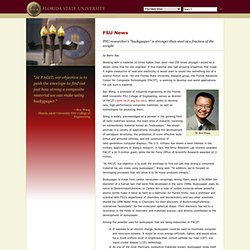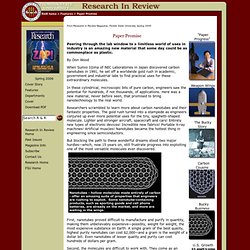

Breakthrough Research Leads to the 3D Printing of Pure Graphene Nanostructures. Founded by Russian entrepreneur Dmitry Itskov in February 2011 with the participation of leading Russian specialists in the field of neural interfaces, robotics, artificial organs and systems.

The main goals of the 2045 Initiative: the creation and realization of a new strategy for the development of humanity which meets global civilization challenges; the creation of optimale conditions promoting the spiritual enlightenment of humanity; and the realization of a new futuristic reality based on 5 principles: high spirituality, high culture, high ethics, high science and high technologies. The main science mega-project of the 2045 Initiative aims to create technologies enabling the transfer of a individual’s personality to a more advanced non-biological carrier, and extending life, including to the point of immortality.
We devote particular attention to enabling the fullest possible dialogue between the world’s major spiritual traditions, science and society. 1. Researcher's "buckypaper" is stronger than steel at a fraction of the weight. By Barry Ray Working with a material 10 times lighter than steel—but 250 times stronger—would be a dream come true for any engineer.

If this material also had amazing properties that made it highly conductive of heat and electricity, it would start to sound like something out of a science fiction novel. Yet one Florida State University research group, the Florida Advanced Center for Composite Technologies (FAC2T), is working to develop real-world applications for just such a material. Dr. Ben Wang Ben Wang, a professor of industrial engineering at the Florida A&M University-FSU College of Engineering, serves as director of FAC2T (www.fac2t.eng.fsu.edu), which works to develop new, high-performance composite materials, as well as technologies for producing them.
Wang is widely acknowledged as a pioneer in the growing field of nano-materials science. "At FAC2T, our objective is to push the envelope to find out just how strong a composite material we can make using buckypaper," Wang said. Research In Review: Paper Promise. Paper Promise Peering through the lab window to a limitless world of uses in industry is an amazing new material that some day could be as commonplace as plastic.

By Don Wood When Sumio Iijima of NEC Laboratories in Japan discovered carbon nanotubes in 1991, he set off a worldwide gold rush in academic, government and industrial labs to find practical uses for these extraordinary molecules. In these cylindrical, microscopic bits of pure carbon, engineers saw the potential for hundreds, if not thousands, of applications. Here was a new material, never before seen, that promised to bring nanotechnology to the real world. Researchers scrambled to learn more about carbon nanotubes and their fantastic properties. But blocking the path to these wonderful dreams stood two major hurdles—which, now 15 years on, still frustrate progress into exploiting one of the most versatile molecules ever discovered. Second, the molecules are difficult to work with.
Delayed Promise “I was fascinated,” Wang said. Buckypaper. Buckypaper, carbon nanotube paper. Buckypapier. Buckypapier besteht aus einer aggregierten Form von Kohlenstoffnanoröhren.[1] Der Durchmesser der zur Herstellung benötigten Nanoröhren beträgt circa 1/50000 des Durchmessers eines menschlichen Haares.[1] Ursprünglich wurde Buckypapier hergestellt, um den Umgang mit Nanoröhren zu verbessern. 2008 wurde herausgefunden, dass diese Aggregate ebenfalls als Baumaterial für Luftfahrzeuge, Körperpanzer und Elektronikartikel verwendet werden können.

Hintergrund[Bearbeiten] Buckypapier ist ein makroskopischer Aggregatszustand der Kohlenstoffnanoröhren. Die Idee zur Herstellung von Buckypapier kam dem Forscher Harold Kroto und Forschern der Rice University, als sie versuchten, die Bedingungen herzustellen, die im Inneren eines Sternes herrschen, wenn elementarer Kohlenstoff entsteht.[1] Seinen Namen verdankt es den Fullerenen, genauer gesagt dem C60 Fulleren (einem Allotroph des Kohlenstoffs mit ähnlichen Bindungen, der zu Ehren von R. Synthese[Bearbeiten] Apparatur für Frit-Kompression.
A simple magnet can control the color of a liquid. Nano.